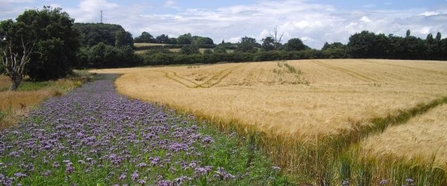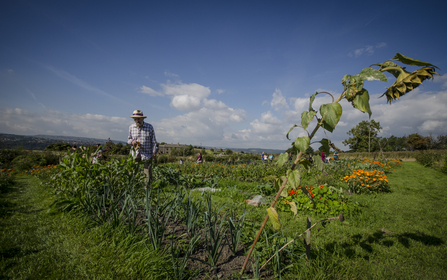Lower Smite Farm, Worcestershire - a working lowland arable farm
A 150 acre working farm in Worcestershire with a nature trail, owned and managed by the Worcestershire Wildlife Trust.
Purchased in 2001, the farm is managed to demonstrate how sensitive farming techniques can improve the quality of the agricultural landscape for wildlife. The Trust uses a wide range of crop types and diverse management strategies to provide wildlife with year round habitat and food.
Restoring farmland soils and foodwebs
Since the post-war drive to intensify farming, the soil at Smite has steadily declined in terms of humus content, organic matter and soil wildlife. As a result it had become almost totally reliant on artificial inputs to grow arable crops and this was associated with costly heavy cultivations to create seedbeds. With around 75% of terrestrial wildlife living in the soil, a thriving soil food web is vital to the recovery of the majority of farmland wildlife, most of which continues to suffer ongoing declines.
Rebuilding soil humus levels and earthworm numbers are a priority at Lower Smite
Rebuilding humus levels and earthworm numbers are a priority at Lower Smite and the Trust have planted a wide range of ‘green manure’ mixes, including red and white clovers, cocksfoot, yellow trefoil and phacaelia to ‘feed’ the soil and encourage microbial activity. These mixes also provide good forage for sheep and cattle. Earthworms are not only the ‘lungs’ of the soil they are directly linked to the survival and abundance of a wide range of farmland wildlife including thrushes, lapwing, curlew, buzzard, moles, badger, robins, rooks, frogs, ants and can even form up to 34% of the diet of foxes. A healthy soil is also fundamental to establishing a resilient cropping system able to cope with the adverse weather patterns created by climate change.
Wide and wildlife-friendly field margins
The farm’s wide field margins - some planted with special seed mix, some left to develop their own flora – encourage a wide range of insects with butterflies frequently observed. Bees and butterflies can also be spotted in good numbers in the gardens in front of the main farmhouse. These are managed to help schoolchildren attending our education centre discover more about the importance of growing your own food and gardening for wildlife.
Organic farming
Half the farmland at Lower Smite is now managed organically and a diverse range of crops is grown including traditional varieties of strawberries, blackcurrants, orchard trees, spring wheat and forage crops. A neighbouring farming family rents the remaining arable land and under the auspices of the Trust grows forage for their dairy herd as well as carrying out operations for the Trust on the organic land.
Higher Level Stewardship
The entire farm is in the Higher Level Stewardship scheme (HLS) which pays land-managers to take areas out of production and focus on creating and maintaining wildlife habitats. Within this scheme the Trust has recently planted over 2 km of hedges, built a bridge and replaced 500m of fencing allowing them to take in livestock which will improve the diversity of the farm’s grasslands.
Helping to restore wildlife to the wider countryside
Wildlife needs connectivity between habitats in order to be able to move about and the Trust is working with neighbours and other landowners to develop innovative approaches to creating corridors which will benefit both wildlife and the local economy. Farming plays an important role in Worcestershire's countryside and has a significant impact on wildlife in the county. Worcestershire Wildlife Trust owns and manages farms at Naunton Beauchamp and Lower Smite as well as managing many other grazed and cultivated fields around the county.

Lower Smite Farm (Worcestershire Wildlife Trust) - Zoe Stevens
Stirley Farm, Yorkshire - an upland community farm
Stirley Farm was an upland dairy farm in Newsome, south east of Huddersfield that went out of business eight years ago. Since then part of the site was marginally farmed, whilst the rest was left vacant. The farm buildings were derelict and the site in disrepair. People regularly used the public rights of way through the site, but a lot of potential for use as a green space was going to waste.
As the owners of the farm buildings and land, a few years ago Kirklees Council approached the Yorkshire Wildlife Trust about the site and nature conservation, whilst input from local activists suggested there might also be some benefit to the community to be gained from renovating the site. Local consultations followed, which proved great support for the idea of Stirley Farm becoming a community resource to demonstrate, inspire and educate people about local food production and growing.
The concept was put to the Cabinet of Kirklees Council in November 2008 who supported a transfer of the land to the Yorkshire Wildlife Trust, and after lots of hard work, planning and business analysis, the project is finally going ahead!
A new farm – for local people and wildlife
Now Yorkshire Wildlife Trust are redeveloping Stirley as an open access community farm providing facilities for a great day out as well as providing opportunities to learn all about a working farm. Stirley Community Farm will be run as a beef social enterprise based on a low input traditional farming model, rearing slow maturing hardy breeds fed on grass and hay grown on the farm. An initial herd of 14 beef shorthorn was established in 2011, and a successful calving season has meant this herd has grown to 26. The farm will be open to all, with a visitor centre and self-guided trails currently under development.
As an example of sustainable farming, Stirley Community Farm will explore and provide a demonstration of concepts such as low carbon farming and land management that will improve the wildlife of the Pennine Fringe. Tree planting is planned to increase woodland cover and provide wood-fuel, whilst pond and wetland areas will be established.
Growing food and bringing people together
The farm is also a base for a wider community vision which looks at local food production and growing as a way of uniting local people and helping to bridge gaps in the community. The vegetable training area has been hugely successful in the first year of the project thanks to the help of all the people who have volunteered their time to maintain it.
Many people and community groups on our doorstep are growing their own food and at Stirley we are creating a variety of food growing areas – ranging from traditional vegetable beds to the Forest Garden - where people can share their skills and knowledge and learn more about 'growing your own' both on the farm and closer to home.
As well as a model of sustainable food production, the land around Stirley Community Farm will also be enhanced to create species rich grassland which will be a haven for wildlife and become a crucial part of the West Yorkshire Living Landscape.

Kate Thorneberry
Abbotts Hall Farm - a modern arable farm
Essex Wildlife Trust purchased the 283 ha arable farm in 1999 and manages it using modern agronomic practices, whilst also farming very much with wildlife in mind. The Trust has gradually introduced changes to the cropping practices of the farm, increasing benefits to wildlife but retaining farm profitability.
These changes have included restoration and creation of hedgerows, the addition of field margins around all fields, restoration and creation of ponds, beetlebank strips through the middle of arable fields and planting woodland on the edges and corners of fields.
The choice of crop species has been changed as some crops support more wildlife and some are more resistant to pests. Essex Wildlife Trust is now producing its own bird seed. Some fields towards the Blackwater Estuary have been established as grazing fields and are often grazed by sheep, but they also offer additional habitats for wildlife to flourish including Skylarks.
A new lake was built, at the time of the coastal realignment and visitors can often see a range of ducks and large numbers of Little Egrets roosting. A good variety of Warblers can be seen around the vegetation at the edges.
A whole range of crops are grown and as visitors walk around the fields, there are signs at the side of the fields to show what is being grown.
